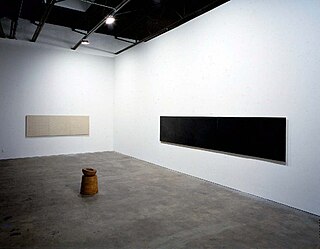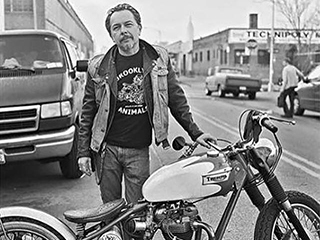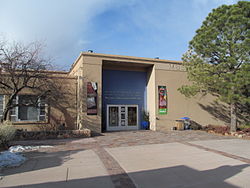History
The museum was founded by Florence Dibell Bartlett and opened to the public in 1953 and has gained national and international recognition as the home to the world’s largest collection of international folk art. The collection of more than 135,000 artifacts forms the basis for exhibitions in four distinct wings: Bartlett, Girard, Hispanic Heritage, and Neutrogena. [2] The original building, a gift to the state from Bartlett, was designed by famed New Mexico architect John Gaw Meem. [3]
The Girard Wing, with its popular exhibition, Multiple Visions: A Common Bond, showcases folk art, popular art, toys and textiles from more than 100 nations. The exhibition is unique in that it was designed by the donor, Alexander Girard, a leading architect and designer. The collection includes toys and dolls, costumes, masks, textiles of all kinds, religious folk art, paintings, beadwork, and more. More than a million visitors have passed through the doors into the special world of Girard since the exhibition opened in 1982. Popular with children and the young at heart, the exhibit attracts visitors back into the museum to find an old favorite, or discover a new treasure in the gallery. Multiple Visions: A Common Bond displays approximately 10% of the collection, the exhibit and collection serve as an inspiration and resource for scholars, artists and educators from around the world, from preschool to college level.
The Museum’s Neutrogena Collection — donated by former Neutrogena CEO Lloyd Cotsen in 1995 — comprises more than 2,500 textiles, ceramics and carvings from all over the world. The Hispanic Heritage Wing opened in 1988 and, at that time, was the only designated space for Spanish/Hispanic art in the state. This wing underwent renovation and reopened in the fall of 2009, continuing its spotlight on Hispanic folk art from New Mexico and beyond.
The Bartlett Wing, named in honor of museum founder Florence Dibell Bartlett, offers rotating exhibitions based on the museum collections and on field studies of specific cultures or art forms. Exhibition in this wing have ranged from Turkish, Tibetan and Swedish traditions to New Deal era art in New Mexico, recycled objects, mayólica, ¡CARNAVAL! and Dancing Shadows, Epic Tales: Wayang Kulit of Indonesia and Macedonian Embroidered Dress The museum is on Museum Hill in Santa Fe, and is home to the International Folk Art Market| Santa Fe every July. The Museum of International Folk Art shares Milner Plaza with another state-run institution, the Museum of Indian Arts and Culture/Laboratory of Anthropology. Adjacent to both of these are the private Wheelwright Museum of the American Indian and Museum of Spanish Colonial Art and the Santa Fe Botanical Garden. [4]

Folk art covers all forms of visual art made in the context of folk culture. Definitions vary, but generally the objects have practical utility of some kind, rather than being exclusively decorative. The makers of folk art are typically trained within a popular tradition, rather than in the fine art tradition of the culture. There is often overlap, or contested ground with 'naive art'. "Folk art" is not used in regard to traditional societies where ethnographic art continue to be made.

The Bowers Museum is an art museum located in Santa Ana, California. The museum's permanent collection includes more than 100,000 objects, and features notable strengths in the areas of pre-Columbian Mesoamerica, Native American art, the art of Asia, Africa, and Oceania, and California plein-air painting. The Bowers organizes and hosts special exhibitions from institutions throughout the world, and travels exhibitions nationally and internationally. The museum has a second campus two blocks south of the main site, Kidseum, a children's museum with a focus on art and archaeology. The Bowers Museum and Kidseum are located in Santa Ana 6.4 km south of Disneyland.

Alexander Girard, affectionately known as Sandro, was an architect, interior designer, furniture designer, industrial designer, and a textile designer.
Florence Dibell Bartlett (1881–1953) was a Chicago heiress and folk art collector, who is best known for founding the Museum of International Folk Art (MOIFA) in Santa Fe, New Mexico, United States, the world's first international folk art museum. The museum was founded to express her belief that folk art is a bond between the people of the world.

African folk art consists of a variety of items: household objects, metal objects, toys, textiles, masks, and wood sculpture. Most traditional African art meets many definitions of folk art generally, or at least did so until relatively recent dates.

The Museum of Indian Arts and Culture is a museum of Native American art and culture located in Santa Fe, New Mexico. It is one of eight museums in the state operated by the New Mexico Department of Cultural Affairs and is accredited by the American Alliance of Museums as part of the Museum of New Mexico system. The museum and its programs are financially supported by the Museum of New Mexico Foundation.

SITE Santa Fe is a nonprofit contemporary arts organization based in Santa Fe, New Mexico. Since its founding in 1995, SITE Santa Fe has presented 11 biennials, more than 90 contemporary art exhibitions, and works by more than 800 artists. Following its presentation of the first international biennial of contemporary art in the U.S., SITE expanded its programming to include ongoing exhibitions of notable artists in solo and group shows, often including new commissions and U.S. debuts. While SITE presents artists from all over the world, it has also provided support and career development opportunities for local New Mexico talent. Approximately 20% of the exhibited artists are based in New Mexico.

Santa Fe is the capital of the U.S. state of New Mexico. With a population of 87,505 at the 2020 census, it is the fourth-most populous city in the state. It is also the county seat of Santa Fe County. Its metropolitan area is part of the Albuquerque–Santa Fe–Los Alamos combined statistical area, which had a population of 1,162,523 in 2020. Human settlement dates back thousands of years in the region. The city was founded in 1610 as the capital of Nuevo México, replacing previous capitals at San Juan de los Caballeros and San Gabriel de Yunque; this makes it the oldest state capital in the United States.

The Mingei International Museum is a non-profit public institution that collects, conserves and exhibits folk art, craft and design. The museum was founded in 1974, and its building opened in 1978. The word mingei, meaning 'art of the people,' was coined by the Japanese scholar Dr. Sōetsu Yanagi by combining the Japanese words for all people and art.

Museo Universitario de Artes Populares María Teresa Pomar is a museum dedicated to Mexico's handcrafts and folk art tradition, called “artesanía.” It is part of the University of Colima in the city of Colima, founded by artesanía collector and promoter María Terea Pomar. It contains one of the most important collections of its type in Mexico, covering traditions from around the country as well as the artesanía and traditions of the state of Colima.

Centro Cultural Mexiquense is a cultural center located on the western edge of the city of Toluca in central Mexico. The center is run by the State of Mexico government through an agency called the Instituto Mexiquense de Cultura (IMC), the largest and most important of this agency, receiving about 80,000 visitors a year. It contains the Museum of Anthropology and History, the Modern Art Museum and the Museum of Popular Cultures as well as a Central Public Library and the Historical Archives of the State of Mexico, as well as facilities for research.
Jacobo de la Serna is a ceramic artist, Spanish Colonial scholar and painter. His work is exhibited in permanent collections around the United States.
María Teresa Pomar (1919-2010) was a collector, researcher and promoter of Mexican handcrafts and folk art along with the communities associated with them. She began as a collector then working with museums to promote handcrafts and then working to found a number of museums and other organizations to the same purpose. She became one of Mexico’s foremost experts on the subject, serving as director of different organizations and judge at competitions in Mexico and abroad. She died in 2010 while she was serving as the director of the Museo Universitario de Artes Populares of the University of Colima, which changed its name to honor her.
Polly Barton is an American textile artist.

Adolphus Clay Bartlett was an American industrialist, the president of Hibbard Spencer Bartlett & Company, the company that originated the label True Value.
Rebecca Salsbury James (1891–1968) was a self-taught American painter, born in London, England of American parents who were traveling with the Buffalo Bill Wild West Show. She settled in New York City, where she married photographer Paul Strand. Following her divorce from Strand, James moved to Taos, New Mexico where she fell in with a group that included Mabel Dodge Luhan, Dorothy Brett, and Frieda Lawrence. In 1937 she married William James, a businessman from Denver, Colorado who was then operating the Kit Carson Trading Company in Taos. She remained in Taos until her death in 1968.

Maie Bartlett Heard (1868–1951) was an Arizona-based collector and philanthropist, who cofounded the Heard Museum of native American art.

Gisella Loeffler (1902–1977) was an Austro-Hungarian–American painter, illustrator and textile artist in a distinctive folk style. She began her career in St Louis, Missouri, before moving to the Taos art colony, New Mexico. Although her style was very different from those of other Taos artists, she was popular with them as well as with the public. Among her best known works are murals she painted in an Albuquerque hospital as part of the 1930s Federal Art Project.

Ray Martìn Abeyta was an American painter. His paintings are a hybrid of historical and contemporary Latino subject matter in the Cuzco School style of Madonna painting, lowrider culture, New Mexican traditional retablo painting, and representations of the colonialist encounters between Europeans and Mesoamericans.
Juanita Jaramillo Lavadie is a contemporary weaver, textile scholar and muralist based in New Mexico. Her art is centered on the acequia system in Taos County, Northern, New Mexico and is influenced by traditional Hispano and Indigenous cultures. Her work primarily focuses on water rights in Taos County.















